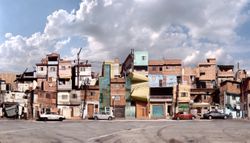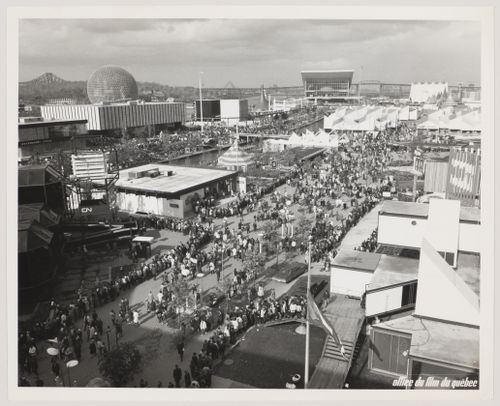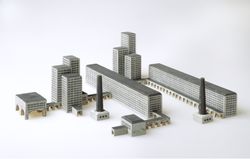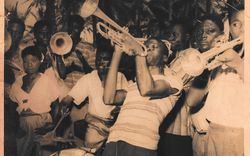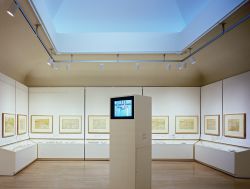documents textuels
DR2004:1450
Description:
Mag box cont. File 'X15/CP/AJ', 'X15 drafts' Bound notebook, Mag box file 'X15 Roy Landau', File X15 (AA), File X15 (exhibition? AA/CP Works II), File 'X15' Originals for 'A Summertime Breeze' homemade publication by CP, Binder X15 (1991-93), Binder 'X15 / 1993-1998', File X15 'Reclamation 88: International Conference / Exhibition on the role of land reclamation in economic regeneration' CP Design, in Organising Committee, 'CP/AJ Special Issue', File 'X15 Canada / 4.11.97'
1970-1998
Mag box cont. File 'X15/CP/AJ', 'X15 drafts' Bound notebook
Actions:
DR2004:1450
Description:
Mag box cont. File 'X15/CP/AJ', 'X15 drafts' Bound notebook, Mag box file 'X15 Roy Landau', File X15 (AA), File X15 (exhibition? AA/CP Works II), File 'X15' Originals for 'A Summertime Breeze' homemade publication by CP, Binder X15 (1991-93), Binder 'X15 / 1993-1998', File X15 'Reclamation 88: International Conference / Exhibition on the role of land reclamation in economic regeneration' CP Design, in Organising Committee, 'CP/AJ Special Issue', File 'X15 Canada / 4.11.97'
documents textuels
1970-1998
Ce jeudi au CCA, en collaboration avec le Cities Programme of the London School of Economics, Gerald Frug, conférencier James Stirling Memorial sur la ville 2010-2011, parle de la conception des systèmes de gouvernance urbaine et de ses répercussions sur le travail des urbanistes et des architectes. Cliquez ici pour l’événement Facebook.
21 octobre 2010
Gerald Frug : L’architecture de la gouvernance
Actions:
Description:
Ce jeudi au CCA, en collaboration avec le Cities Programme of the London School of Economics, Gerald Frug, conférencier James Stirling Memorial sur la ville 2010-2011, parle de la conception des systèmes de gouvernance urbaine et de ses répercussions sur le travail des urbanistes et des architectes. Cliquez ici pour l’événement Facebook.
documents textuels
AP206.S2.003
Description:
File was originally housed in a binder along with content arranged in AP206.S2.002, AP206.S2.004 and AP206.S2.005. This file includes the following papers: “Education of an Architect bearing in mind the Economic, Cultural, and Technical needs of the Country,” 1970 "Architecture as a Career," 1970 "Introduction to the Exhibition of Theatre Architecture," speech delivered in 1961 “Presidential Address on the Occasion of the Inauguration of the Exhibition of International Modern Architecture Organised by the DPAA,” speech “On behalf of the Modern Architects Club," speech “Coordination of Works in Chandigarh” “The City Beautiful,” 1958
1949-1974
Published and unpublished papers (folder 2 of 4)
Actions:
AP206.S2.003
Description:
File was originally housed in a binder along with content arranged in AP206.S2.002, AP206.S2.004 and AP206.S2.005. This file includes the following papers: “Education of an Architect bearing in mind the Economic, Cultural, and Technical needs of the Country,” 1970 "Architecture as a Career," 1970 "Introduction to the Exhibition of Theatre Architecture," speech delivered in 1961 “Presidential Address on the Occasion of the Inauguration of the Exhibition of International Modern Architecture Organised by the DPAA,” speech “On behalf of the Modern Architects Club," speech “Coordination of Works in Chandigarh” “The City Beautiful,” 1958
documents textuels
1949-1974
ARCH256020
Description:
Right row (bottom to the top): Cuban Pavilion = Pavilion of Cuba; Pavilion of Economic Progress; Chatelaine House; Africa Place; Thailand Pavilion = Thai Pavilion; Canadian Pulp and Paper Pavilion; Canadian Pacific-Cominco Pavilion. Middle right row (bottom to the top): - CN Pavilion = C.N.R. Pavilion = Canadian National Pavilion; - Kodak Pavilion = Canadian Kodak Pavilion; - Africa Place; - Steel Pavilion. Middle left row (bottom to the top): - Czechoslovak National Pavilion = Pavilion of Czechoslovakia; - Venezuelan Pavilion = Pavilion of Venezuela; - Pavilion of Ethiopia = Ethiopian Pavilion; - Pavilion of the Soviet Union = USSR Pavilion. Left-row (bottom to the top): Sainte Hélène Island: - Pavilion of the United States = American Pavilion = USA Pavilion.
1967
Partial view of the Île Notre-Dame site, Expo 67, Montréal, Québec
Actions:
ARCH256020
Description:
Right row (bottom to the top): Cuban Pavilion = Pavilion of Cuba; Pavilion of Economic Progress; Chatelaine House; Africa Place; Thailand Pavilion = Thai Pavilion; Canadian Pulp and Paper Pavilion; Canadian Pacific-Cominco Pavilion. Middle right row (bottom to the top): - CN Pavilion = C.N.R. Pavilion = Canadian National Pavilion; - Kodak Pavilion = Canadian Kodak Pavilion; - Africa Place; - Steel Pavilion. Middle left row (bottom to the top): - Czechoslovak National Pavilion = Pavilion of Czechoslovakia; - Venezuelan Pavilion = Pavilion of Venezuela; - Pavilion of Ethiopia = Ethiopian Pavilion; - Pavilion of the Soviet Union = USSR Pavilion. Left-row (bottom to the top): Sainte Hélène Island: - Pavilion of the United States = American Pavilion = USA Pavilion.
Projet
AP056.S1.1988.PR04
Description:
This project series documents the first scheme and final design of The Design Exchange in Toronto from 1988-1994. The office identified the project numbers as 8801 for the first scheme and 9231 for the final design. Although two project numbers were used, materials for each project cannot be clearly separated. This project consisted of the renovation, restauration and expansion of the old Toronto Stock Exchange building, located at the base of the Ernst Young Tower in the Toronto Dominion Centre. The Design Exchange (D/X) was a new cultural institution, dedicated to the economic and cultural promotion of design in the country through exhibits, lectures, banquets, trade shows and other events. With Shirley Blumberg as the partner-in-charge, the art deco style trading floor was restored as an open event space, with the original Charles Comfort murals retained. In order to create harmony between the art deco building and the neo-modernist renovations, bold, linear architectural elements such as stairs, walls, screens and bridges were reiterated throughout the design. A staircase from the trading floor led to an overlooking bridge and created a connection between the trading floor, trading gallery and resource centre. Other areas of the 40,000 square foot building included an exhibit space, café, member's lounge, retail store, seminar rooms and administrative offices. Coloured planes of cobalt blue, chartreuse and ochre were set against a material palette of red oak, cherry, limestone, glass and stainless steel. The project is recorded through drawings and photographs dating from 1988-1994. The drawings are mostly originals and include a large amount of sketches. Also included are plans, elevations, sections, perspectives, details and drawings for custom furnishings. The photographs show the completed interiors of the building.
1988-1994
The Design Exchange, Toronto (1988-1994)
Actions:
AP056.S1.1988.PR04
Description:
This project series documents the first scheme and final design of The Design Exchange in Toronto from 1988-1994. The office identified the project numbers as 8801 for the first scheme and 9231 for the final design. Although two project numbers were used, materials for each project cannot be clearly separated. This project consisted of the renovation, restauration and expansion of the old Toronto Stock Exchange building, located at the base of the Ernst Young Tower in the Toronto Dominion Centre. The Design Exchange (D/X) was a new cultural institution, dedicated to the economic and cultural promotion of design in the country through exhibits, lectures, banquets, trade shows and other events. With Shirley Blumberg as the partner-in-charge, the art deco style trading floor was restored as an open event space, with the original Charles Comfort murals retained. In order to create harmony between the art deco building and the neo-modernist renovations, bold, linear architectural elements such as stairs, walls, screens and bridges were reiterated throughout the design. A staircase from the trading floor led to an overlooking bridge and created a connection between the trading floor, trading gallery and resource centre. Other areas of the 40,000 square foot building included an exhibit space, café, member's lounge, retail store, seminar rooms and administrative offices. Coloured planes of cobalt blue, chartreuse and ochre were set against a material palette of red oak, cherry, limestone, glass and stainless steel. The project is recorded through drawings and photographs dating from 1988-1994. The drawings are mostly originals and include a large amount of sketches. Also included are plans, elevations, sections, perspectives, details and drawings for custom furnishings. The photographs show the completed interiors of the building.
Project
1988-1994
Nous tendons aujourd’hui à percevoir les banlieues comme informes, vacantes ou non durables, comparées à la densité sociale et à l’activité économique des villes. Sur les traces de… The Suburbs se penche sur la culture suburbaine des cinquante dernières années et présente des images tirées de la Collection du CCA, réalisés par des photographes à la fois attirés et rebutés(...)
Vitrines
16 février 2012 au 10 juin 2012
Sur les traces de… The Suburbs
Actions:
Description:
Nous tendons aujourd’hui à percevoir les banlieues comme informes, vacantes ou non durables, comparées à la densité sociale et à l’activité économique des villes. Sur les traces de… The Suburbs se penche sur la culture suburbaine des cinquante dernières années et présente des images tirées de la Collection du CCA, réalisés par des photographes à la fois attirés et rebutés(...)
Vitrines
Les progrès de la technique, aussi bien que les conditions sociales, politiques et économiques, ont de tout temps influencé les architectes. L’exposition Les jouets et la tradition moderniste examine la manière dont les fabricants de jouets ont reçu les multiples idées novatrices des architectes modernes. Plusieurs des jouets exposés ont été conçus par des figures(...)
16 décembre 1993 au 1 mai 1994
Les jouets et la tradition moderniste
Actions:
Description:
Les progrès de la technique, aussi bien que les conditions sociales, politiques et économiques, ont de tout temps influencé les architectes. L’exposition Les jouets et la tradition moderniste examine la manière dont les fabricants de jouets ont reçu les multiples idées novatrices des architectes modernes. Plusieurs des jouets exposés ont été conçus par des figures(...)
articles
Le rythme de la modernisation
Dele Adeyemo relit la production de l’espace d’un Ghana en voie de modernisation à travers le highlife
Actions:
articles
Escalade d’engagement
Pour votre sécurité
25 mars 2024
Escalade d’engagement
Shane Reiner-Roth retrace le développement de l'infrastructure autoroutière de Los Angeles
Actions:
Pour votre sécurité
*Montréal, ville fortifiée du XVIIIe siècle* explore l’évolution de la ville au XVIIIe siècle, alors qu’elle était une ville fortifiée. Cet événement offre une occasion unique de se renseigner sur l’essor de la ville commerciale et militaire à l’origine de la métropole actuelle. Couronnant presque quinze années de recherche et la création d’une(...)
Salles principales
8 septembre 1992 au 28 février 1993
Montréal, ville fortifiée au XVIIIe siècle
Actions:
Description:
*Montréal, ville fortifiée du XVIIIe siècle* explore l’évolution de la ville au XVIIIe siècle, alors qu’elle était une ville fortifiée. Cet événement offre une occasion unique de se renseigner sur l’essor de la ville commerciale et militaire à l’origine de la métropole actuelle. Couronnant presque quinze années de recherche et la création d’une(...)
Salles principales
